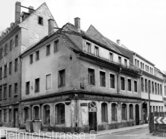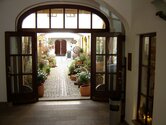History of the Dresden Baroque District
Once the "Cradle of Dresden". Today the "parlor" of our City.
No one seriously battles about if the first settlement of men was left or right of the river Elbe and started the development of Dresden to one of the most fascinating cities worldwide. But historians are certain that it was on the shores of todays Baroque District.
First not more than a small Slavic Village, it grew to a greater settlement until the 12th century. In the year 1350 it is first mentioned in a document as „Antiqua Dressdin“. By 1430 „Altendresden“ was granted municipal rights by margrave Wilhelm I. and the right to hold a market. This included the rights to buy and sell all kinds of goods, brew and serve beer, bake bread and to practice handcrafts.
One gets the impression that the district still follows these ancient rules and guidelines, even though times changed. Within the 16th century roghly 1500 people lived in Altendresden. By the middle of the 17th century there were already 346 inhabited houses, and twelve linen weavers, 17 taverns and 28 butchers. There was a church, a school, an infirmary and a midwife.
The first bridge to connect Altendresden with “Dresdene” (todays historical center) was built in 1222, made out of wood. Shortly after, in 1287 the bridge was rebuilt in stone, one of only four stone built bridges in Europe.
The year 1685
On August the 6th of the year 1685 a great fire broke out in the house of master carpenter Tobias Edler in Meißner Gasse – between present Blockhaus and Hotel Westin Bellevue. Because most of the houses were built out of wood, the fire spread uncontrollably and destroyed 336 buildings. Only 18 to 20 houses closely to Elbe were spared, as well as the Jägerhof (presently museum for Saxon folk art) and the old town hall, because they were already built out of stone.
The homeless people had to sleep on the meadows of the waterside of the river. Many of them lost everything in the fire and roamed the streets bagging for money for the following years in poverty.
The former monarch, elector Johann Gregor III. ordered his provincial building master Wolf Caspar von Klengel with the reconstruction of the district. Klengel had visionary plans, mainly orientated towards French and Italian urban architecture. But he failed, mostly due to the protest by the former inhabitants who wanted to their new houses to be built on the old foundation walls.
Altendresden becomes August's “New Kingtown”
Altendresden remained as a wasteland and eyesore for more than 30 years. But after August the Strong started his reign, he purchased the Japanese Palais in 1717 to house his famous collection of porcelain. The surroundings of the Palais certainly did not fit the appearance August had in mind for his city.
So he decided to built his „New Kingtown“ right here. August the Strong ( Friedrich August I. Elector of Saxony and August II. King in Poland) reminded himself of Klengels vision and planned the Koenigsstrasse as a direct visual axis from the Japanese Palais on, all by himself. The properties lining the street were given away for free, but strict construction plans had to be kept. For instance:
- Everything needed to be built in stone (because of the fire hazard),
- no house is allowed to be higher than the Japanese Palais,
- all houses need the same storey hight and number,
- the buildings needed courtyards that opened towards the sky, entrances must be in the middle of the building and need to - have front decoration,
- all houses have to be painted in bright colours and
- the houses must have appartments to rent out for foreigners (real novelty).
Because of the strict construction plans of August the Strong, Königsstraße developed into a boulevard of great noblesse and beauty. The buildings nr. 1, 3, 7, 10 and 12 are original witnesses of the more than 300 year old building regulations.
The forking alleys Heinrichstraße, Obergraben and Rähnitzgasse had the same regulations. For example Rähnitzgasse Nr. 14: it was built around 1730 by the same man who built the Augustus bridge and Ephiphany church and finished the Frauenkirche (Chirch of Our Lady) after the death of George Bähr. Council master builder Johann Gottlieb Fehre. Today this exact house hosts the only romantic hotel of Dresden. On Hauptstrasse you will find the beautifully reconstructed houses Nr. 13, 15, 17 and 19, amongst others home of the Museum of Dresden Romanticism, the Kuegelgenhaus and the arts and crafts courtyards.
The intellectual elite on a visit
Since the middle of the 18th century, one can confidently say that the quarter hosted some of the most intelligent people of its period: Goethe, Schiller, Kleist, Mozart, Humboldt, Canaletto, Caspar David Friedrich, Dahl, Runge, Graff, Schopenhauer, Nietzsche, Winckelmann, Herder, Schlegel, Novalis and many more.
This is mostly due to two enlightened men and patrons who not only displayed exemplary hospitality, but also hosted an intellectual salon for art, philosophy and politics: the painter Gerhardt von Kügelgen and the attorney, journalist and publisher Christian Gottfried Körner.
Not to forget is a woman – the most renowed female portrait and pastel painter of Saxony, as well as the sister-in-law of Körner: Dora Stock. Her independent ways of thinking and her esprit were one main cause for the success of the literary salon in the house of Körner. She even made the informed choice not to marry, a very uncommon decision at the time.
It is for the family Körner that the world got gifted Schillers „Ode to Joy“. It was composed in honour of Körner and his wife Minna. Without their help Schiller might have starved.
It is well known that Schopenhauer sold his home in the noble historical centre to settle in the Baroque District instead. The spirit of the enlightened bourgeoisie seemed better for his own thinking. His main work „Die Welt als Wille und Vorstellung“ (The world as will and representation) was written here in 1819.
Throughout the 19th century several different architects set new structural accents: Rococo, Biedermeier, Classicism and Wilhelminian architecture. The Dresdner Nieritzstraße is well-known amongst architects of all around the world: there are only a few Biedermeier buildings that survived until today – in Nieritzstraße there is even a whole street built in this particular style. In the course of industrialisation more and more workmen settled in the quarter. There even was a time when it was well-known as the prostitutes quarter.
The Year 1945 ... then the GDR came over Dresden
As a consequence of the bombardment of Dresden in 1945 the quarter got heavily damaged but not completely destroyed. The houses burnt out but remained standing. A far greater harm was done by the GDR era. Neither for maintenance measures nor for building materials there was any financial support by the government. Therefore some of the house owners left their homes and moved to a central heated plattenbau, a prefabricated building, or to West Germany.
The Quarter was condemned to demolition.
But it got saved, mostly by people, like students, artists and young couples who were not assigned a n accommodation and illegally moved into the empty buildings. With lots of creativity they managed to patch up the leaky roofs against the dripping rain and thereby saved the original historic structure of many buildings
The Baroque District - The front parlour of Dresden
The political turn in 1989 made it possible for the quarter to regain its unique beauty. The buildings were restituted to their former owners or sold. With many efforts they were and some are still restored and renovated.
Today the Neuständer Baroque District is one of the most beautiful quarters in Dresden. Downright close to the centre of town but still secluded enough. It is a place to live and to work, to trade and stop off at one of the many restaurants, taverns and cafés. The small stores and shops, galleries, ateliers, boutiques, jewellery workshops and bars are daily operated by the owners themselves. They set a focus on excellent consultation, quality and service. The residents of town lovingly compare the quarter with the 'Gute Stube' (front parlour) of Dresden. Guests and visitors enjoy the best quality of accommodations in town, not only Hotelrooms, even a fine selection of vacation rentals and holiday flats in Dresden running by private renters.
A creative atmosphere invites the visitors to stroll, wonder and rest. No place else in Dresden unites this many artistic, crafty, cultural, enjoyable and individual locations in such small area. A pub close to a top-quality restaurant, second hand and vintage clothing next to custom tailors and artist's studios besides museums.
And in addition: the famous CANALETTO-view is to be found here. Canaletto painted the world famous silhouette of the historical centre from the river shores of Baroque District in 1748 (beneath today Hotel Westin Bellevue).
























